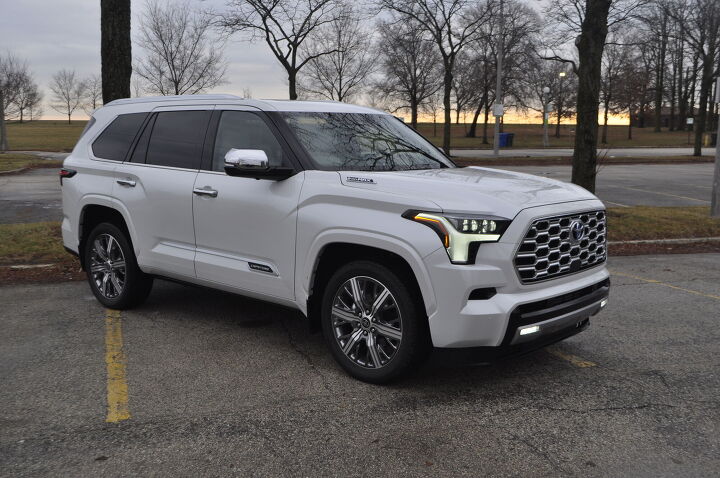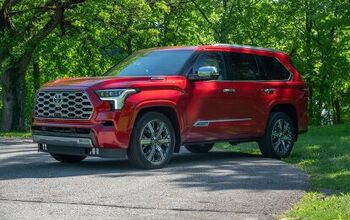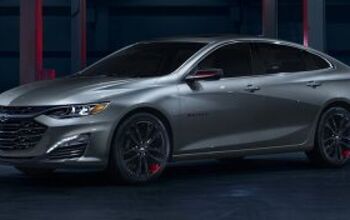2023 Toyota Sequoia Review – Comfortable Yet Cold

2023 Toyota Sequoia Platinum and Capstone Fast Facts
Large, family-hauling SUVs prioritize comfort for obvious reasons. With the 2023 Toyota Sequoia, the brand also tried to be stylish. One mission accomplished, one not so much.
As an enthusiast, the Sequoia is easy to pick on – its driving dynamics are blandly competent with little spark for the sporty-minded family man or woman. As a utility vehicle, the Sequoia works a bit better – at least as well as anything in its competitive set. As something that’s meant to appeal to the eye, well, styling is obviously subjective, but I found it to be less than pleasing to the eye.
This review will be an unusual dual-trim review – I drove two separate Sequoias within a short time of one another. They’re not different enough to justify two separate reviews. So, let’s kill two birds – trees? – with one stone. Metaphorically speaking, of course.
The Sequoia’s styling follows the blocky look of Toyota’s full-size Tundra truck. The look works better on the outside than it does on the Tundra – and better on the Sequoia’s outside than its inside. That said, it’s still a bit of an old-school design that eschews swoopy styling or even a simple, plain boxy look and while it’s not ugly, it’s not, at least to my eye, head-turning attractive.
A gaping grille and large lower front fascia busy up the look. The Capstone trim I drove had chrome accents integrated into the grille.
Inside, the blocky look again comes across as too busy, though there’s some good stuff here. The big infotainment screen looks wedged in, but its size is appreciated by aging eyes, and Toyota’s revamped infotainment is worlds better than what it replaces. Interior materials seemed nice enough for the respective price in both trims I drove, though the Capstone’s cabin looks and feels more premium, with the white trim giving it more personality. The climate and audio buttons are easy enough to learn and use, and I appreciated the nice amount of storage in the center console area. The wireless cell phone charger being angled toward the driver is a nice touch.
Creature comfort isn’t the issue here – the Sequoia is roomy and quiet, save for muted engine roar from the 3.5-liter twin-turbo V6 when the hybrid’s gas motor comes alive. That’s right, the sole powertrain available on the Sequoia is a hybrid that pairs the 3.5 with an electric motor/generator that’s located between the 10-speed automatic transmission and the engine. Total power is 437 horsepower and 583 lb-ft of torque.
It’s a smooth powertrain, with enough low-end grunt for standard commuting, but this a heavy vehicle and you feel it. The Platinum trim I drove was a bit lighter since it was rear-wheel drive, but it’s still over 5,800 pounds. The ride is unsurprisingly smooth for both trims – I didn’t notice much difference between the 20-inch rims the Platinum rode on and the 22-inchers sported by the Capstone. Handling is best described as blandly competent – it’s dialed in fairly well for such a heavy vehicle and it’s not too ponderous, but the word “sporty” won’t be shooting across your mind, either. Heavy, numb steering that feels a little disconnected doesn’t help.
Towing capacity for a two-drive Platinum is 9,310 pounds and for the four-wheel drive Capstone it’s 8,980 pounds.
The Platinum I drove is the mid-trim out of five (SR5, Limited, Platinum, TRD Pro, Capstone) and it comes with 20-inch wheels, LED headlights, LED taillights, LED fog lamps, blind-spot monitoring, leather seats, heated and cooled front and rear seats, second-row captain’s chairs, power-fold third-row seats, power tilt/telescope steering wheel, heated steering wheel, panoramic sunroof, wireless cell phone charging, tri-zone climate control, keyless entry and starting, wireless Apple CarPlay and Android Auto, and satellite radio. Options included a towing package, navigation, and power running boards.
The Capstone added the aforementioned 22s, auto-leveling headlights, and made the running boards standard. A dash cam was a key option, with the other two options being a ball mount and the Wind Chill Pearl White paint.
Active and passive safety systems on both trims included radar cruise control, lane-departure alert with steering assist, pre-collision system with pedestrian detection, blind-spot monitoring, and rear-cross traffic alert.
As-tested price for the Platinum was $70,900 and the Capstone checked in at $80,906.
Fuel economy checks in at 19/22/20 for all four-wheel-drive Sequoias and 21/24/22 for all two-wheel-drive versions.
From a pure function standpoint, the Sequoia is just fine, and the Capstone even gives more than a hint of luxury, even if its cabin, while nice, isn’t quite as ostentatious as that you might find in a Cadillac or Lincoln.
Yeah, the driving dynamics are a bit bland – you generally expect that in this segment. The biggest issue here is love-it-or-leave-it styling. That and a lack of panache that you see from its rivals.
The Sequoia won’t embarrass you in the carpool lane, but it won’t make your neighbors jealous, either. At this price point, that might not be enough.
[Images © 2023 Tim Healey/TTAC, Toyota]
Become a TTAC insider. Get the latest news, features, TTAC takes, and everything else that gets to the truth about cars first by subscribing to our newsletter.

Tim Healey grew up around the auto-parts business and has always had a love for cars — his parents joke his first word was “‘Vette”. Despite this, he wanted to pursue a career in sports writing but he ended up falling semi-accidentally into the automotive-journalism industry, first at Consumer Guide Automotive and later at Web2Carz.com. He also worked as an industry analyst at Mintel Group and freelanced for About.com, CarFax, Vehix.com, High Gear Media, Torque News, FutureCar.com, Cars.com, among others, and of course Vertical Scope sites such as AutoGuide.com, Off-Road.com, and HybridCars.com. He’s an urbanite and as such, doesn’t need a daily driver, but if he had one, it would be compact, sporty, and have a manual transmission.
More by Tim Healey
Latest Car Reviews
Read moreLatest Product Reviews
Read moreRecent Comments
- SCE to AUX Red flags everywhere on this one. The mods are a negative, and what good is upgraded suspension that hasn't moved in 15 years?This car needs a total overhaul, and $18k for a basketcase is a bad starting point.
- Theflyersfan Yet another seller grossly overvaluing what could/will likely become a project car because with those aftermarket mods, it's anyone's guess how it's holding up now. Even the two comments in the listing are letting the seller know that he's asking too much. And that's a shame because this is one desirable Japan bubble-era car to snag. But if it can't pass California smog, it likely won't pass emissions in states that are close or meets their inspection limits so that knocks out a big chunk of the west and east coasts. So, bring a truck and a trailer and be prepared to haul it a distance. These sellers need to be real. Aftermarket turbos aren't going to help reliability in the long run. Expect a total engine inspection/rebuild as part of this project. New body work and paint. Replace everything that is rubber from tires to belts to hoses. Professional cleaning of interior and possibly new upholstery depending on the damage done by 15 years of sitting and rotting. Given the work and transportation/towing involved, even $10,000 might be too high. Someone will want this, that's for sure, but the seller needs to adjust expectations a bit.
- Bd2 These vehicles, especially when compared to Hyundai models of the same time were total junk even when new.
- Theflyersfan I'll leave a note under this guy's windshield letting them know that they need to park their car until it can get fixed. I'm sure he'll understand.
- SCE to AUX [list=1][*]CfC: The fuel economy of a Sentra is so high that the required gain (25%, I think) to make the vehicle qualify meant that there were few cars that could beat it. Besides, a Sentra owner is unlikely to be in a position to take on a new car payment. Despite the cash, you still had to buy the new car.[/*][*]Takata recall: So 11% of these vehicles remain untouched. Some people think recalls are for chumps, because they know their car better than anybody, and because the dealer is going to try to rip them off somehow.[/*][/list=1]Honda had the same problem trying to contact owners. I think we've reached the point where due diligence has been exercised.










































Comments
Join the conversation
P
Jeff S.
Pathfinder sales are up 200%-it's not going anywhere.
How does a review in this class not cover the 3rd row or cargo area? Well, it turns out that both are pretty weak in the Sequoia. It's got far too many compromises for an all new vehicle at this price point.